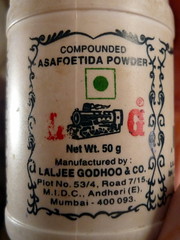 |
Two new sesquiterpene coumarins, designated 5′-acetoxy-8′-hydroxyumbelliprenin (1) and 10′R-acetoxy-11′-hydroxyumbelliprenin (2), and a new diterpene, 15-hydroxy-6-en-dehydroabietic acid (3), along with 27 known compounds, were isolated from a CHCl3-soluble extract of Ferula assa-foetida through bioassay-guided fractionation. Structures of the new metabolites 1−3 were identified by spectroscopic data interpretation and by the Mosher ester method. Compounds 4 and 6−13 showed greater potency against influenza A virus (H1N1) (IC500.26−0.86 μg/mL) than amantadine (IC50 0.92 μg/mL), and 11 exhibited the best potency (IC500.51, 2.6, and 3.4 μg/mL) of these compounds against the HepG2, Hep3B, and MCF-7 cancer cell lines, respectively. Image and text credit. Lee et al 2009. PMID: 19691312 |
The results that were obtained from the bioassays performed showed that the compounds that were isolated from f. asafoetida demonstrated powerful anti-viral properties. In fact the compounds that were being tested did far better than the control, amatadine, which is a popular antiviral drug in the market. The team also looked at the cytotoxic properties of the compound and found a few compounds that demonstrated powerful cytotoxic properties, having inhibited rapid cell multiplication making it a potential therapeutic agent against cancer,
Traditional medicines and home remedies have been around for a while and seem to have something to offer for every ailment, right from a common cough and cold to psoriasis and migraine. It is high time we took a closer look at them and the properties they offer rather than just disregard them on grounds of having no scientific backing for their claims. Studies like these show us the importance of keeping an unbiased and an open mind to every thing. Just because something has been followed for generations does not necessarily mean it is blind faith. This is exactly what science teaches us, not to accept things at their face value. Rerum Cognoscere Causas, to discover the cause of things.
Reference:
Lee CL, Chiang LC, Cheng LH, Liaw CC, Abd El-Razek MH, Chang FR, & Wu YC (2009). Influenza A (H(1)N(1)) Antiviral and Cytotoxic Agents from Ferula assa-foetida. Journal of natural products, 72 (9), 1568-72 PMID: 19691312




